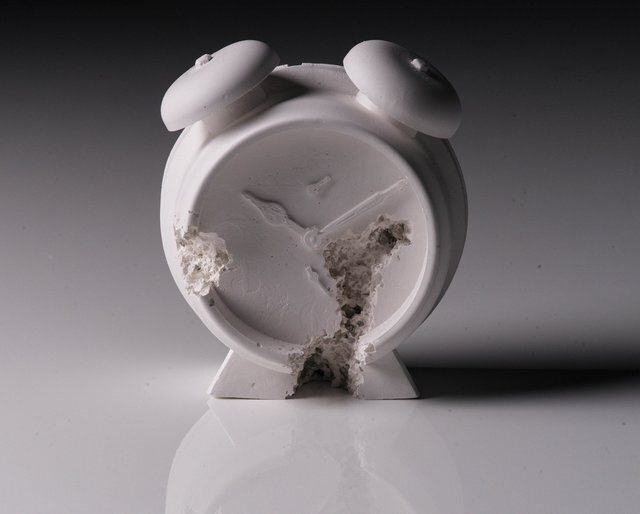Reflecting on Time Poverty — Future Relics by Daniel Arsham
Daniel Arsham’s ‘Future Relics’ series predicts the excavation of objects from the present. It feels strange to look at a familiar and useful object and to also register it as a defunct and crumbling relic; how can a thing represent a past, a present and a future all at once? These objects, Arsham explains, ‘create breaks in time and they expand and collapse it by bringing us outside of our current moment’.
Of all of these time-bending things, I am most drawn to the clocks. To force a time keeping object through time and back again is to play God: the eroded clock conjures a romance between past, present and future; it reveals that they can contain each other. I find it really calming to look at – it nudges me towards the peaceful realisation that (and this happens always in Lana del Rey’s silky voice with accompanying instrumental) ‘all time is unredeemable’. Future time bores holes in the past's material – time can’t be recovered and it can’t be vetoed, and we are also relics crumbling at its whim.
Daniel Arsham Eroded Clock, 2020
This is easy enough to accept, but there can be an urgency to these objects. They are a reminder that the present is constantly eroding away. Suitably, any reflections that this art brings will be interrupted as future commitments become present and then past ones, and so it goes on. In this way a future relic is a comment on our own personal time, which ages and crumbles irredeemably. Although this crumbling is inevitable, I see external pressures that contribute to a feeling of eroded time everywhere: having ‘no time’ is normalised since busyness is equated with status and success; time is fragmented and then fragmented again by task-based work; there are so many things we could do that the time we do have could never possibly feel like enough. The internet is a time-guzzling seductress and bureaucracy is almost institutionally sanctioned procrastination. Inject this with a healthy dose of pecuniary cliché (time is money!), and it’s no wonder we feel time poor.
Daniel Arsham Future Relic 03 - Clock, 2016
This dreary kind of erosion has none of the romance or intrigue of Arsham’s future relics – an equivalent might present a clock hammered and bent, or smashed to dusty pieces. What can these relics show us beyond clocks that are better off than our own? To be constructive, I think we have to make these objects about preservation. Archaeology involves preserving the past, and Arsham creates the illusion of archaeology by preserving the present, announcing it as a study of both the past and the future. Time is absolute where societally and organisationally constructed pressures are not, and time poverty is a very psychologically driven phenomenon: we are all guilty of undervaluing our time, and this creates its own dusty mess.
There is no concrete methodology to valuing time because value is subjective and nobody is the same. But preserving yourself, whatever that might mean to you, feels important. Future relics tell us that preservation starts now – time won’t stop, but we can hold our shape.
Words: Alice Keeling


